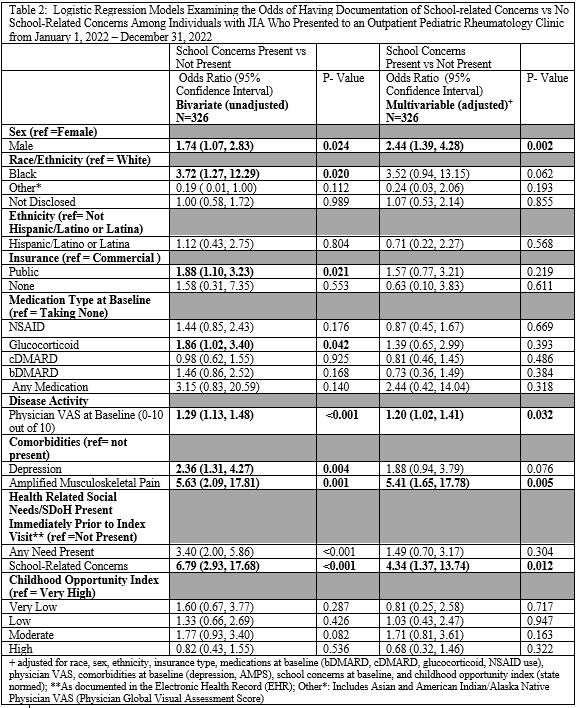Children with Chronic Conditions 3
Session: Children with Chronic Conditions 3
462 - School-Related Concerns Among Individuals with Juvenile Idiopathic Arthritis
Monday, April 28, 2025
7:00am - 9:15am HST
Publication Number: 462.6102
Mia Chandler, Boston Children's Hospital, Boston, MA, United States; Laura Berbert, Boston Children's Hospital, Boston, MA, United States; Madeline Hlobik, Boston Children's Hospital, Chicago, IL, United States; Aditi A. Deokar, Boston Children's Hospital, Boston, MA, United States; Mary Beth F.. Son, Boston Children's Hospital, Brookline, MA, United States; Joyce Chang, Boston Children's Hospital, Brookline, MA, United States
- MC
Mia Chandler, MD, MPH
Instructor of Pediatrics
Boston Children's Hospital
Boston, Massachusetts, United States
Presenting Author(s)
Background: Juvenile idiopathic arthritis (JIA) is associated with significant physical and functional disabilities. Disease activity may negatively impact school function.
Objective: The purpose of this study is to examine factors that may be associated with the presence of school-related concerns (SRC) among individuals with JIA.
Design/Methods: Design: Retrospective cohort study; Setting: Urban free-standing academic pediatric medical center; Population: Individuals with JIA, ages 5-21 years old, seen in a the rheumatology clinic; Assessment Period: January 1, 2022-December 31, 2022; Primary Outcome: Presence of SRC, a composite variable that included (1) the presence of SRC documented on a patient-reported needs assessment questionnaire or (2) in the free text of electronic health records (EHR); Primary Exposure: Physician Global Visual Assessment Score (PhysVAS) at baseline (last visit in 2021). Multivariable logistic regression models were used to test associations of PhysVAS and other individual or area-level factors, such as the Childhood Opportunity Index 2.0, with SRC.
Results: We identified 528 individuals with JIA, of which 326 with PhysVAS scores were included in the primary analysis (Table 1). The cohorts of included (with PhysVAS) vs excluded (without PhysVAS) individuals were similar, although there was a slightly higher proportion of males in the excluded cohort. Over a third of individuals (116/326, 35.6%) had documented SRC during the assessment period. Black race, public insurance, disease activity (PhyVAS), glucocorticoid use, depression and amplified musculoskeletal pain (AMPS) at baseline were associated with statistically significant higher odds of having school-related concerns in unadjusted analyses. In adjusted models, having a PhysVAS >0 (OR 1.20, 95%CI 1.02, 1.41), male sex (OR 2.44, 95% CI 1.39, 4.28), or AMPS (OR 5.41, 95% CI 1.65, 17.78) remained statistically significant however, race, ethnicity, medication type and COI were not associated with SRC.
Conclusion(s): In this single center cohort of individuals with JIA, we observed statistically significant associations between disease activity (PhysVAS), male sex, and amplified musculoskeletal pain with school-related concerns (SRC). Point estimates suggest there may be an association between Black race and SRC, albeit it was not statistically significant. These findings warrant further investigation in larger, more diverse samples. Complete disease control, prevention of disease flares, and high-quality treatment for AMPS among individuals with JIA are potential targets of interventions to mitigate school-related concerns.
Table 1
.jpg)
Table 2

Table 1
.jpg)
Table 2


